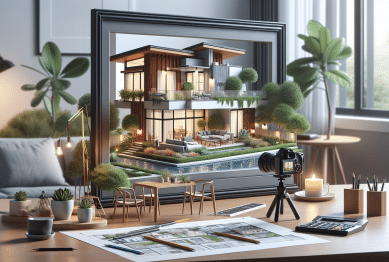The sustainable real estate trends defining 2025 are no longer side projects or “nice-to-have” features—they are shaping the foundation of property development, investment, and urban planning. The real estate industry has moved beyond simply constructing energy-efficient buildings to reimagining entire communities with sustainability at their core.
Entrepreneurs, investors, and developers are recognizing that sustainable properties not only reduce environmental impact but also enhance long-term profitability, attract higher-quality tenants, and improve community resilience. This year, the spotlight is on innovations like mass timber cities, green affordable housing finance, and commercial decarbonization powered by climate tech—trends backed by serious capital and strong regulatory support.
Let’s explore the most impactful sustainable real estate trends of 2025, why they matter, and how they’re creating new opportunities for industry leaders.

1. Mass Timber Construction: The Rise of Wooden Cities
From Concept to Reality
One of the most ambitious sustainable real estate trends is the large-scale use of mass timber construction. The best-known example is Stockholm Wood City in Sweden—set to be the largest urban district built entirely from engineered wood. This groundbreaking development will span 25 blocks, including 2,000 homes, 7,000 office spaces, schools, retail areas, and green spaces. Construction is slated to begin in 2025, with completion expected in the early 2030s.
The project uses cross-laminated timber (CLT) and glue-laminated timber (GLT), materials that are lighter than concrete yet structurally strong. These materials lock in carbon for decades and require far less energy to produce than traditional building materials like steel and cement.
Benefits Driving the Trend
- Carbon reduction: Replacing steel and concrete with mass timber could cut building emissions by up to 60%.
- Construction efficiency: Prefabricated wooden components allow faster builds and reduced noise pollution.
- Occupant wellbeing: Research shows wooden interiors can lower stress, improve productivity, and create a warmer ambiance compared to concrete spaces.
Global Expansion of the Concept
Stockholm is not alone—Canada, Japan, and parts of the U.S. are also investing in timber-based high-rises. In Portland, Oregon, the Framework Building is a 12-story mass timber tower that set a precedent for U.S. building codes. Japan’s Sumitomo Forestry is planning a 350-meter wooden skyscraper in Tokyo to commemorate its 350th anniversary.
2. Green Affordable Housing: Sustainability Meets Social Equity
A Billion-Dollar Push in Emerging Markets
While luxury eco-developments often make headlines, one of the most transformative sustainable real estate trends is green affordable housing—ensuring that sustainability is accessible to lower- and middle-income households.
In early 2025, the International Finance Corporation (IFC) partnered with HDFC Capital Advisors to create a 1 billion dollars fund dedicated to developing energy-efficient, affordable housing in India. The goal is to integrate features like solar power, rainwater harvesting, and natural ventilation into cost-effective housing developments.
Why This Matters
- Climate alignment: Affordable housing is often built with cheaper, less efficient materials—this initiative changes that narrative.
- Financial inclusion: Affordable green housing attracts social impact investors, broadening funding opportunities.
- Community resilience: Lower utility costs help residents weather economic fluctuations.
Examples Beyond India
- Brazil’s Minha Casa Minha Vida program has started adding energy-efficient measures to low-cost housing.
- Kenya’s Green Affordable Housing Program uses modular construction to cut costs and reduce waste.
These projects prove that sustainability doesn’t have to be a privilege—it can be a standard.
3. Decarbonizing Commercial Real Estate with Climate-Tech
Tech-Driven Change
Commercial real estate contributes about 20% of total U.S. greenhouse gas emissions. With climate disclosure laws tightening, building owners face pressure to retrofit and decarbonize.
In India, Carbon Guardians is helping property owners achieve carbon neutrality in managed office spaces. The company targets ₹100 crore (12 million dollars) in revenue by 2028, reflecting demand for turnkey sustainability solutions.
In the U.S., Galvanize Climate Solutions, founded by billionaire investor Tom Steyer, is committing nearly 2 billion dollars to develop and retrofit commercial spaces into energy-efficient assets over the next three years.
Decarbonization Strategies Include:
- Deep energy retrofits with advanced insulation and HVAC systems
- On-site renewable energy generation (solar, wind, geothermal)
- Smart building systems for real-time energy optimization
- Low-carbon materials for renovations and new builds
4. Regulatory Pressures Accelerating Adoption
Governments are shaping the trajectory of sustainable real estate trends through legislation:
- EU Green Deal & Energy Performance of Buildings Directive (EPBD): Sets minimum energy performance standards for all buildings.
- U.S. SEC Climate Disclosure Rules: Mandates ESG reporting for publicly traded companies, including property holdings.
- India’s Energy Conservation Building Code (ECBC): Requires commercial buildings to meet specific energy efficiency benchmarks.
These rules create financial incentives for compliance and penalties for lagging behind, making sustainability a matter of regulatory survival.
5. ESG as an Investment Imperative
Investors increasingly view sustainability as a value driver, not a cost center. According to a 2025 Knight Frank survey, 63% of institutional investors plan to prioritize ESG-compliant assets in their portfolios.
Key Drivers of Investor Interest:
- Tenant demand: Corporate tenants want green-certified spaces to meet their own ESG targets.
- Lower operational costs: Energy efficiency and water conservation reduce long-term expenses.
- Asset value protection: Green buildings are less vulnerable to future regulatory risks.
6. Technology Integrations in Sustainable Real Estate
Technology is no longer optional—it’s the backbone of new sustainable real estate trends:
- AI-driven energy management: Predicts peak usage times and adjusts systems automatically.
- Blockchain for ESG reporting: Ensures transparent, tamper-proof sustainability metrics.
- Digital twins: Simulate building performance to optimize design before construction.
These innovations make sustainability measurable, trackable, and verifiable—addressing investor and regulatory concerns about “greenwashing.”
7. How Entrepreneurs Can Leverage These Trends
For entrepreneurs in real estate, 2025 is a prime moment to align business models with sustainability. Practical steps include:
- Specialize in eco-material sourcing: Partner with timber suppliers or recycled material manufacturers.
- Offer green retrofit services: Target commercial properties seeking compliance upgrades.
- Develop modular, green housing units: Shorten construction timelines while minimizing waste.
- Bundle financing with sustainability consulting: Help clients secure green loans and subsidies.
Summary: Top Sustainable Real Estate Trends of 2025
| Trend | Significance | Example Project |
|---|---|---|
| Mass Timber Cities | Carbon storage, speed, occupant wellness | Stockholm Wood City (Sweden) |
| Green Affordable Housing | Equity + environment, scalable impact | IFC-HDFC 1B dollars Fund (India) |
| Commercial Decarbonization | Compliance + cost savings, tech integration | Galvanize Climate Solutions (U.S.) |
| ESG-Driven Investment | Attracting capital and securing asset value | Knight Frank Survey |
| Tech-Enabled Sustainability | Measurable, verifiable, automated performance | AI & blockchain-based systems |
Conclusion
As we move deeper into 2025, sustainable real estate trends are rewriting the rules of property development and investment. Mass timber cities are proving that entire urban districts can be carbon-negative. Green affordable housing is ensuring sustainability reaches all income levels. Commercial real estate is being transformed by climate-tech, and investors are prioritizing ESG compliance as a measure of long-term value.
For industry leaders, this is not just about staying compliant—it’s about staying competitive. Entrepreneurs who align with these trends now will be positioned at the forefront of a market that increasingly rewards sustainability with higher returns, stronger tenant relationships, and long-term resilience.
References
- Reuters. (2024, August 28). Steyer’s Galvanize eyes new asset class in green commercial property. Reuters. Available at: https://www.reuters.com (Accessed: 13 August 2025).
- The Economic Times. (2025, February 18). IFC, HDFC Capital partner for green affordable housing finance in India with 1 billion dollars fund. The Economic Times. Available at: https://economictimes.indiatimes.com (Accessed: 13 August 2025).
- Time. (2024, July 1). Inside Stockholm Wood City, the world’s largest timber-built neighborhood. Time.
Available at: https://time.com (Accessed: 13 August 2025).









